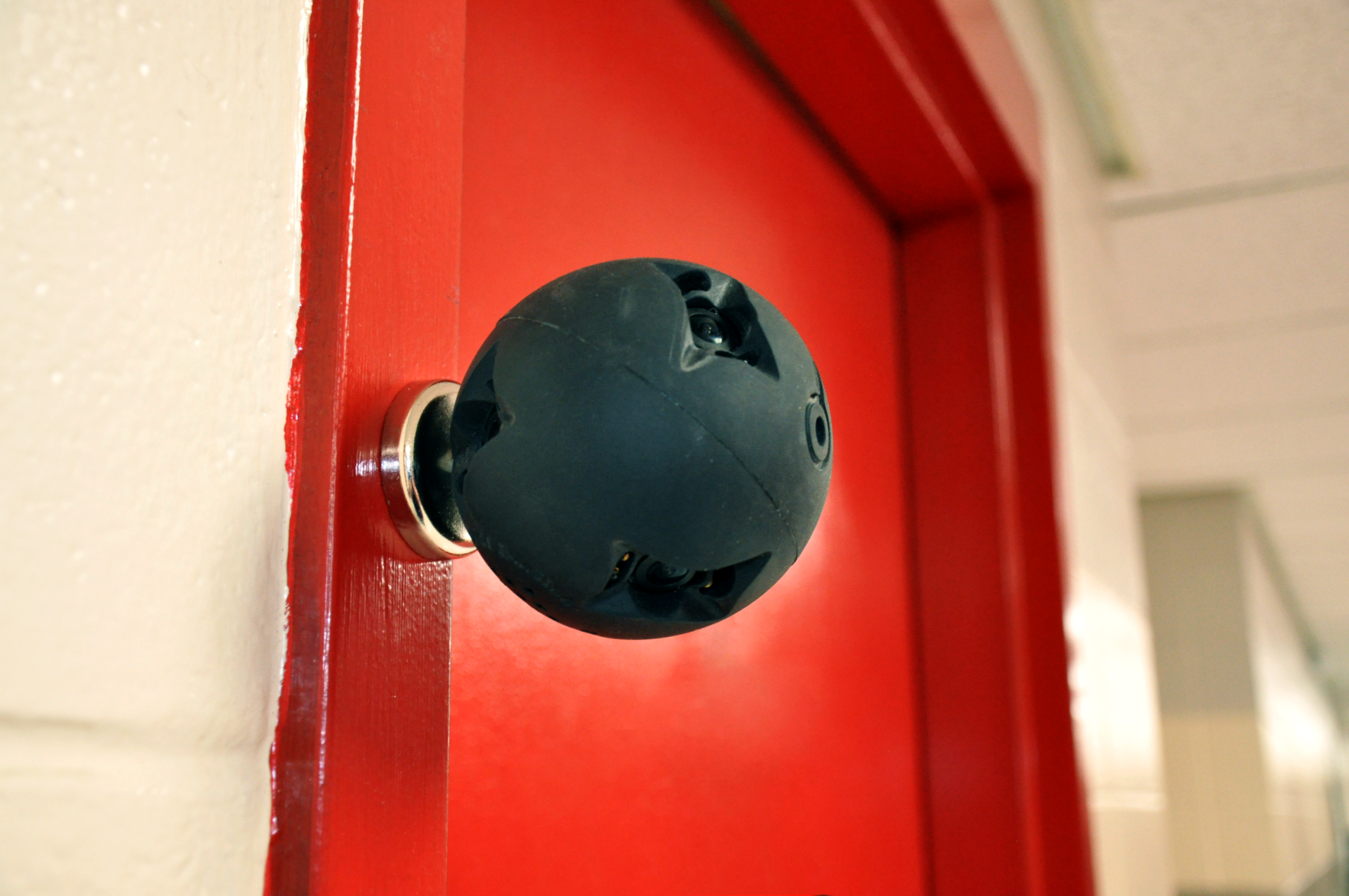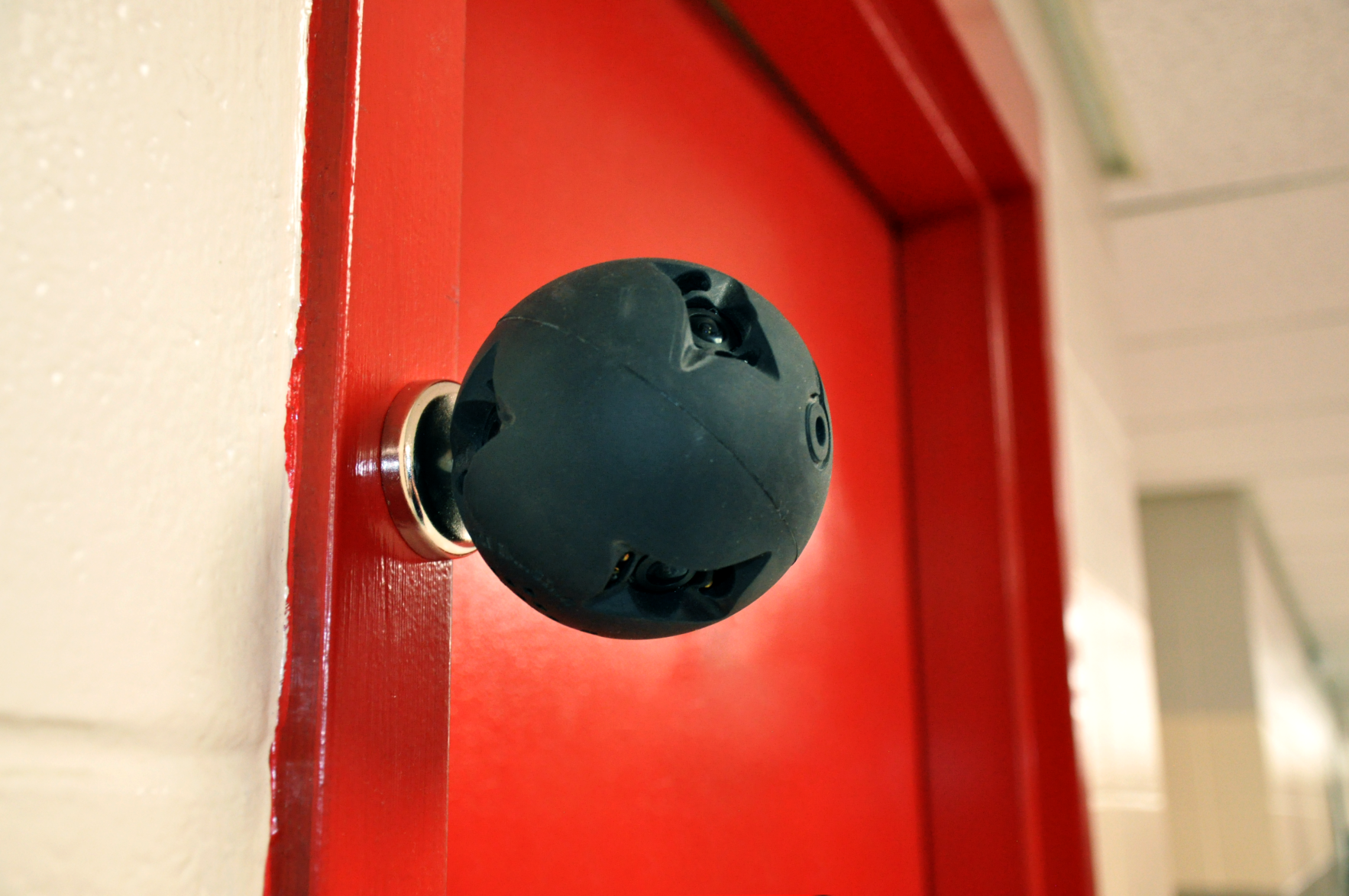By ELIZABETH SUMMERS | The Reporter | Apr 23, 2021
The Reporter | Elizabeth Summers
Marshall County Chief of Corrections Matt Cooper, left, Marshall County Sheriff’s Office Assistant Chief Steve Guthrie and Sheriff Phil Sims watch a live video feed from the camera ball during a demonstration Thursday. The Marshall County Sheriff’s Office is the first law enforcement agency in Alabama to buy the camera ball.
The Marshall County Sheriff’s Office became the first law enforcement agency in the state to purchase special camera balls for tactical and rescue use.
Thursday morning, Marshall County Sheriff Phil Sims, Assistant Chief Steve Guthrie, Chief of Corrections Matt Hooper and Blount County Captain of the Special Response Team Ron Adkins joined with Ty St. Clair, Southeast Regional Sales Manager of Bounce Imaging, to show off the equipment’s capabilities.
The black hard rubber ball features six cameras that work together to send image-stabilized video in real time. The ball has a central mounting screw allowing the ball to be placed on a pole, tether, magnet or even attached to a K-9 vest. Each application is designed to keep officers out of harm’s way while gathering as much information as possible about a potentially dangerous situation.
“We had a guy barricade himself in an attic of a house last summer,” Sims said. “We could have put this on a pole and checked in the attic to see exactly where he was, if he was armed or injured, and not once put an officer in danger.
“There are so many ways this could be utilized … SWAT, tactical, in hostage situations in the jail, barricade situations, rescue situations after a tornado, for example … just about anything.”
Sims said his office purchased two of the Bounce Imaging Explorer Unleashed model, which is about the size of a softball, at a cost of $4,500 each. The items have 4G wi-fi capability and are accessible by officials via a unique QR code. Sims can even access the camera views from remote location, such as his office or the command center, St. Clair said. The camera balls are expected to arrive within a few weeks, Sims said.
The Reporter | Elizabeth Summers
“I hope we never have to use this,” Sims said. “But if we have them, we can save a lot of time and protect our deputies and the public.”
Sims said the camera balls will replace at least three different pieces of equipment, the main one being what is referred to as a “throw phone,” commonly used during standoff or barricade situations.
“A throw phone is essentially a phone in a box attached to about 200 yards of cable,” Sims said. “It is thrown into a room or space where the subject is holed up. We can initiate a call to them or they can pick it up and call us.
“But it takes time to set up. The suspect can just ignore it and not pick up the handset to talk.”
The camera balls are equipped with two-way communication capabilities and infrared modes.
Sims said he saw a demonstration by St. Clair and “immediately knew we had to have some of them.”
St. Clair demonstrated by rolling the camera ball down a hallway at the high school. Sims, Guthrie and others were able to see real-time video of the ball rolling past side halls, lockers and water fountain alcoves.
Sims was able to issue a command for School Resource Office Hester Hollis to come out of a hallway with his hands up.
“If we roll this down a hallway during a school shooting incident, we can see who is in the hall, where they are, what they may have in their possession such as guns or knives … all without putting a man out there in harm’s way,” Sims said. “We can see any movement behind officers when they make entry and are able to communicate that to them.”
The camera ball may also be mounted to a magnet and attached to a doorframe or lockers to give views of halls or other areas.
Placing it on a pole gives access to attic or ventilation spaces.
Adding a tether allows operators to retract the camera ball after throwing it into what is discovered to be an empty room, or to use the tether to drop the camera ball down a hole, cave, shaft or stairwell.
The camera ball is nearly indestructible, St. Clair said.
“During a demonstration in Marietta, Georgia, they wanted to toss it up onto a stairwell landing,” he said. “They missed, and it hit a railing and dropped about 15 feet to the concrete below.
“These are military grade and will withstand a lot. They can even be thrown through a window to gain views of a hostage situation.”
Each camera ball has a battery life of about 3 ½ hours, St. Clair said.
All footage is saved to the Cloud, St. Clair said, and can be later accessed for court or evidentiary use.
“Our goal is to protect people and preserve lives,” St. Clair said.
Guthrie said the demonstration was held at Asbury High School because the school was the first to have a full-time School Resource Officer and the demonstration works best in a school setting.




